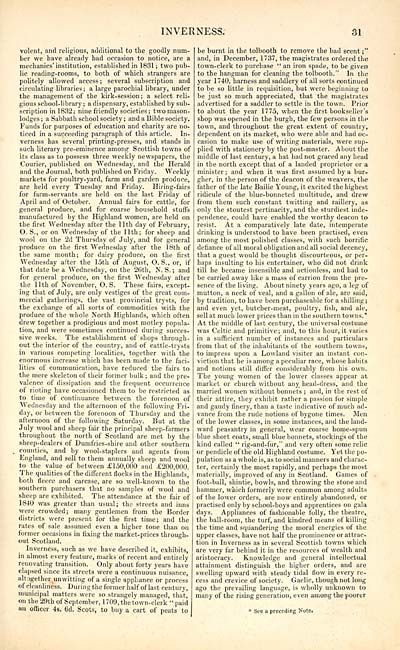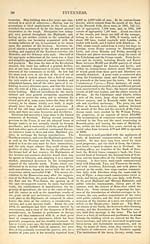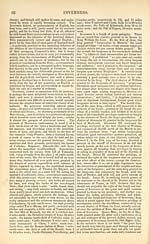Download files
Complete book:
Individual page:
Thumbnail gallery: Grid view | List view

INVERNESS.
31
volent, and religious, additional to the goodly num-
ber we have already had occasion to notice, are a
mechanics' institution, established in 1831 ; two pub-
lic reading-rooms, to both of which strangers are
politely allowed access ; several subscription and
circulating libraries ; a large parochial library, under
the management of the kirk-session ; a select reli-
gious school-library ; a dispensary, established by sub-
scription in 1832; nine friendly societies ; two mason-
lodges ; a Sabbath school society ; and a Bible society.
Fmids for purposes of education and charity are no-
ticed in a succeeding paragraph of this article. In-
verness has several printing-presses, and stands in
such literary pre-eminence among Scottish towns of
its class as to possess three weekly newspapers, the
Courier, published on Wednesday, and the Herald
and the Journal, both published on Friday. Weekly
markets for poultry-yard, farm and garden produce,
are held every Tuesday and Friday. Hiring-fairs
for farm-servants are held on the last Friday of
April and of October. Annual fairs for cattle, for
general produce, and for coarse household stuffs
manufactured by the Highland women, are held on
the first Wednesday after the 11th day of February,
O. S., or on Wednesday of the 11th; for sheep and
wool on the 2d Thursday of July, and for general
produce on the first Wednesday after the 18th of
the same month; for dairy produce, on the first
Wednesday after the 15th of August, O. S., or, if
that date be a Wednesday, on the 26th, N. S.; and
for general produce, on the first AVednesday after
the 11th of November, O. S. These fairs, except-
ing that of July, are only vestiges of the great com-
mercial gatherings, the vast provincial trysts, for
the exchange of all sorts of commodities with the
produce of the whole North Highlands, which often
drew together a prodigious and most motley popula-
tion, and were sometimes continued during succes-
sive weeks. The establishment of shops through-
out the interior of the country, and of cattle-trysts
in various competing localities, together with the
enormous increase which has been made to the faci-
lities of communication, have reduced the fairs to
the mere skeleton of their former bulk ; and the pre-
valence of dissipation and the frequent occurrence
of rioting have occasioned them to be restricted as
to time of continuance between the forenoon of
AVednesday and the afternoon of the following Fri-
day, or between the forenoon of Thursday and the
afternoon of the following Saturday. But at the
July wool and sheep fair the principal sheep-farmers
throughout the north of Scotland are met by the
sheep-dealers of Dumfries-shire and other southern
counties, and by wool-staplers and agents from
England, and sell to them annually sheep and wool
to the value of between £150,000 and £200,000.
The qualities of the different flocks in the Highlands,
both fleece and carcase, are so well-known to the
southern purchasers that no samples of wool and
sheep are exhibited. The attendance at the fair of
1840 was greater than usual; the streets and inns
were crowded; many gentlemen from the Border
districts were present for the first time; and the
rates of sale assumed even a higher tone than on
former occasions in fixing the market-prices through-
out Scotland.
Inverness, such as we have described it, exhibits,
in almost every feature, marks of recent and entirely
renovating transition. Only about forty years have
elapsed since its streets were a continuous nuisance,
altogether unwitting of a single appliance or process
of cleanliness. During the former half of last century,
municipal matters were so strangely managed, that,
on the 29th of September, 1709, the town-clerk "paid
an officer 4s. 6d. Scots, to buy a cart of peats to
be burnt in the tolbooth to remove the bad scent ;"
and, in December, 1737, the magistrates ordered the
town-clerk to purchase " an iron spade, to be given
to the hangman for cleaning the tolbooth." In the
year 1740, harness and saddlery of all sorts continued
to be so little in requisition, but were beginning to
be just so much appreciated, that the magistrates
advertised for a saddler to settle in the town. Prior
to about the year 1775, when the first bookseller's
shop was opened in the burgh, the few persons in the
town, and throughout the great extent of country,
dependent on its market, who were able and had oc-
casion to make use of writing materials, were sup-
plied with stationery by the post-master. About the
middle of last century, a hat had not graced any head
in the north except that of a landed proprietor or a
minister ; and when it was first assumed by a bur-
gher, in the person of the deacon of the weavers, the
father of the late Bailie Young, it excited the highest
ridicule of the blue-bonneted multitude, and drew
from them such constant twitting and raillery, as
only the stoutest pertinacity, and the sturdiest inde-
pendence, could have enabled the worthy deacon to
resist. At a comparatively late date, intemperate
drinking is understood to have been practised, even
among the most polished classes, with such horrific
defiance of all moral obligation and all social decency,
that a guest would be thought discourteous, or per-
haps insulting to his entertainer, who did not drink
till he became insensible and actionless, and had to
be carried away like a mass of carrion from the pre-
sence of the living. About ninety years ago, a leg of
mutton, a neck of veal, and a gallon of ale, are said,
by tradition, to have been purchaseable for a shilling;
and even yet, butcher-meat, poultry, fish, and ale,
sell at much lower prices than in the southern towns.*
At the middle of last century, the universal costume
was Celtic and primitive; and, to this hour, it varies
in a sufficient number of instances and particulars
from that of the inhabitants of the southern towns,
to impress upon a Lowland visiter an instant con-
viction that be is among a peculiar race, whose habits
and notions still differ considerably from his own.
The young women of the lower classes appear at
market or church without any head-dress, and the
married women without bonnets ; and, in the rest of
their attire, they exhibit rather a passion for simple
and gaudy finery, than a taste indicative of much ad-
vance from the rude notions of bygone times. Men
of the lower classes, in some instances, and the land-
ward peasantry in general, wear coarse home-spun
blue short coats, small blue bonnets, stockings of the
kind called " rig-and-fur," and very often some relic
or pendicle of the old Highland costume. Yet the po-
pulation as a whole is, as to social manners and charac-
ter, certainly the most rapidly, and perhaps the most
materially, improved of any in Scotland. Games of
foot-ball, shintie, bowds, and throwing the stone and
hammer, which formerly were common among adults
of the lower orders, are now entirely abandoned, or
practised only by school-boys and apprentices on gala
days. Appliances of fashionable folly, the theatre,
the ball-room, the turf, and kindred means of killing
the time and squandering the moral energies of the
upper classes, have not half the prominence or attrac-
tion in Inverness as in several Scottish towns which
are very far behind it in the resources of wealth and
aristocracy. Knowledge and general intellectual
attainment distinguish the higher orders, and are
swelling upward with steady tidal flow in every re-
cess and crevice of society. Gaelic, though not long
ago the prevailing language, is wholly unknown to
many of the rising generation, even among the poorer
* See a preceding Nute.
31
volent, and religious, additional to the goodly num-
ber we have already had occasion to notice, are a
mechanics' institution, established in 1831 ; two pub-
lic reading-rooms, to both of which strangers are
politely allowed access ; several subscription and
circulating libraries ; a large parochial library, under
the management of the kirk-session ; a select reli-
gious school-library ; a dispensary, established by sub-
scription in 1832; nine friendly societies ; two mason-
lodges ; a Sabbath school society ; and a Bible society.
Fmids for purposes of education and charity are no-
ticed in a succeeding paragraph of this article. In-
verness has several printing-presses, and stands in
such literary pre-eminence among Scottish towns of
its class as to possess three weekly newspapers, the
Courier, published on Wednesday, and the Herald
and the Journal, both published on Friday. Weekly
markets for poultry-yard, farm and garden produce,
are held every Tuesday and Friday. Hiring-fairs
for farm-servants are held on the last Friday of
April and of October. Annual fairs for cattle, for
general produce, and for coarse household stuffs
manufactured by the Highland women, are held on
the first Wednesday after the 11th day of February,
O. S., or on Wednesday of the 11th; for sheep and
wool on the 2d Thursday of July, and for general
produce on the first Wednesday after the 18th of
the same month; for dairy produce, on the first
Wednesday after the 15th of August, O. S., or, if
that date be a Wednesday, on the 26th, N. S.; and
for general produce, on the first AVednesday after
the 11th of November, O. S. These fairs, except-
ing that of July, are only vestiges of the great com-
mercial gatherings, the vast provincial trysts, for
the exchange of all sorts of commodities with the
produce of the whole North Highlands, which often
drew together a prodigious and most motley popula-
tion, and were sometimes continued during succes-
sive weeks. The establishment of shops through-
out the interior of the country, and of cattle-trysts
in various competing localities, together with the
enormous increase which has been made to the faci-
lities of communication, have reduced the fairs to
the mere skeleton of their former bulk ; and the pre-
valence of dissipation and the frequent occurrence
of rioting have occasioned them to be restricted as
to time of continuance between the forenoon of
AVednesday and the afternoon of the following Fri-
day, or between the forenoon of Thursday and the
afternoon of the following Saturday. But at the
July wool and sheep fair the principal sheep-farmers
throughout the north of Scotland are met by the
sheep-dealers of Dumfries-shire and other southern
counties, and by wool-staplers and agents from
England, and sell to them annually sheep and wool
to the value of between £150,000 and £200,000.
The qualities of the different flocks in the Highlands,
both fleece and carcase, are so well-known to the
southern purchasers that no samples of wool and
sheep are exhibited. The attendance at the fair of
1840 was greater than usual; the streets and inns
were crowded; many gentlemen from the Border
districts were present for the first time; and the
rates of sale assumed even a higher tone than on
former occasions in fixing the market-prices through-
out Scotland.
Inverness, such as we have described it, exhibits,
in almost every feature, marks of recent and entirely
renovating transition. Only about forty years have
elapsed since its streets were a continuous nuisance,
altogether unwitting of a single appliance or process
of cleanliness. During the former half of last century,
municipal matters were so strangely managed, that,
on the 29th of September, 1709, the town-clerk "paid
an officer 4s. 6d. Scots, to buy a cart of peats to
be burnt in the tolbooth to remove the bad scent ;"
and, in December, 1737, the magistrates ordered the
town-clerk to purchase " an iron spade, to be given
to the hangman for cleaning the tolbooth." In the
year 1740, harness and saddlery of all sorts continued
to be so little in requisition, but were beginning to
be just so much appreciated, that the magistrates
advertised for a saddler to settle in the town. Prior
to about the year 1775, when the first bookseller's
shop was opened in the burgh, the few persons in the
town, and throughout the great extent of country,
dependent on its market, who were able and had oc-
casion to make use of writing materials, were sup-
plied with stationery by the post-master. About the
middle of last century, a hat had not graced any head
in the north except that of a landed proprietor or a
minister ; and when it was first assumed by a bur-
gher, in the person of the deacon of the weavers, the
father of the late Bailie Young, it excited the highest
ridicule of the blue-bonneted multitude, and drew
from them such constant twitting and raillery, as
only the stoutest pertinacity, and the sturdiest inde-
pendence, could have enabled the worthy deacon to
resist. At a comparatively late date, intemperate
drinking is understood to have been practised, even
among the most polished classes, with such horrific
defiance of all moral obligation and all social decency,
that a guest would be thought discourteous, or per-
haps insulting to his entertainer, who did not drink
till he became insensible and actionless, and had to
be carried away like a mass of carrion from the pre-
sence of the living. About ninety years ago, a leg of
mutton, a neck of veal, and a gallon of ale, are said,
by tradition, to have been purchaseable for a shilling;
and even yet, butcher-meat, poultry, fish, and ale,
sell at much lower prices than in the southern towns.*
At the middle of last century, the universal costume
was Celtic and primitive; and, to this hour, it varies
in a sufficient number of instances and particulars
from that of the inhabitants of the southern towns,
to impress upon a Lowland visiter an instant con-
viction that be is among a peculiar race, whose habits
and notions still differ considerably from his own.
The young women of the lower classes appear at
market or church without any head-dress, and the
married women without bonnets ; and, in the rest of
their attire, they exhibit rather a passion for simple
and gaudy finery, than a taste indicative of much ad-
vance from the rude notions of bygone times. Men
of the lower classes, in some instances, and the land-
ward peasantry in general, wear coarse home-spun
blue short coats, small blue bonnets, stockings of the
kind called " rig-and-fur," and very often some relic
or pendicle of the old Highland costume. Yet the po-
pulation as a whole is, as to social manners and charac-
ter, certainly the most rapidly, and perhaps the most
materially, improved of any in Scotland. Games of
foot-ball, shintie, bowds, and throwing the stone and
hammer, which formerly were common among adults
of the lower orders, are now entirely abandoned, or
practised only by school-boys and apprentices on gala
days. Appliances of fashionable folly, the theatre,
the ball-room, the turf, and kindred means of killing
the time and squandering the moral energies of the
upper classes, have not half the prominence or attrac-
tion in Inverness as in several Scottish towns which
are very far behind it in the resources of wealth and
aristocracy. Knowledge and general intellectual
attainment distinguish the higher orders, and are
swelling upward with steady tidal flow in every re-
cess and crevice of society. Gaelic, though not long
ago the prevailing language, is wholly unknown to
many of the rising generation, even among the poorer
* See a preceding Nute.
Set display mode to: Large image | Transcription
Images and transcriptions on this page, including medium image downloads, may be used under the Creative Commons Attribution 4.0 International Licence unless otherwise stated. ![]()
| Gazetteers of Scotland, 1803-1901 > Topographical, statistical, and historical gazetteer of Scotland > Volume 2 > (41) Page 31 |
|---|
| Permanent URL | https://digital.nls.uk/97449082 |
|---|
| Description | Volume second: I-Z. |
|---|---|
| Shelfmark | Map Room Ref.2 |
| Attribution and copyright: |
|

